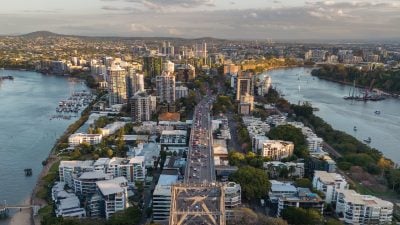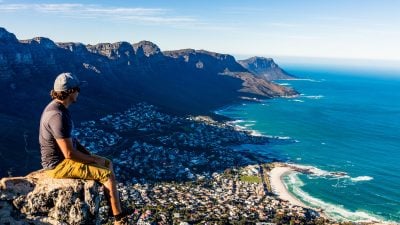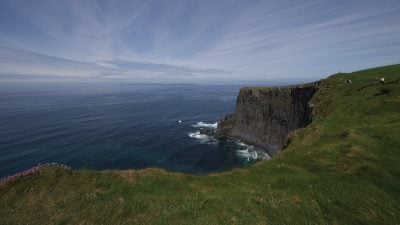Home / Australia & South Pacific / Eight Iconic Sites to See on a…

Eight Iconic Sites to See on a Downunder Vacation
The most outstanding sites on a Downunder vacation are numerous and should not be missed. What’s on your bucket list?
My intention here is to highlight the top 8 iconic sites in Australia and New Zealand, natural or otherwise, that are my favourites that I have personally experienced and have what I call the “Wow Factor.” Over time, I have visited over 80 countries in the world and, by the way, there are officially 195 altogether. I am sure you will agree that to whittle down the choice to 8 sites is not easy. However, after giving this some thought, I have only selected those (in no particular preferential order) that are generally known and cherished… let’s see if they coincide with yours.
1. Sydney Opera House – Sydney, Australia
The Sydney Opera House is located on the shores of Sydney Harbour and cannot be missed on an Australian vacation. It has to be one of the world’s most easily recognizable buildings. This is due to its totally unique design, a masterpiece of 20th Century architecture. Not only is it a multi-venue performance hall but it is a site to which visitors to Sydney are immediately drawn. The effect of viewing the Opera House is both dramatic and unforgettable. The design of the roof, which is so well known, is a series of large shell-shaped sails. The building was designed by the Danish architect, Jorn Utzon, whose design was selected from a total of 232 competitive designs. It actually took 16 years to build and was eventually opened in 1973 by Queen Elizabeth II. In 2007, it was designated a UNESCO World Heritage Site and the organization described it as “a great urban sculpture set in a remarkable waterscape at the tip of a peninsula projecting into Sydney Harbour.” There are 7 performance venues where 2500 performances take place annually. The largest is the Concert Hall. The Opera House contains one of the world’s largest organs, which has 10,000 pipes.
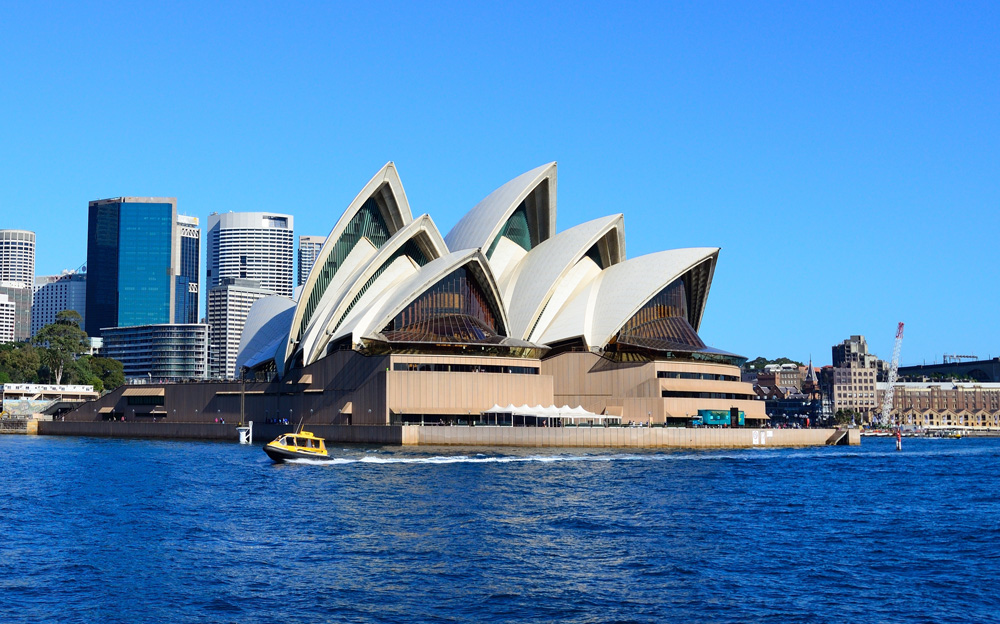
2. Sydney Harbour Bridge – Sydney, Australia
It is possible the first sight and site that comes to mind when thinking of Sydney, Australia is the Sydney Harbour Bridge, as it is impossible to avoid seeing it, being an amazing architectural phenomenon. First opened in 1932, it connects the Sydney Central Business District with the North Shore of the city and is the gateway to Sydney Harbour. Spanning the harbour, the bridge is a spectacular feat of engineering. It is the world’s tallest steel arch bridge and a vital link in Sydney’s transport infrastructure with more than 200,000 cars travelling its length each day. It is affectionately known as the “Coat Hanger.” It has a similar place in Sydney history as the Statue of Liberty has to New York. Construction began in 1924 and it took 1400 men 8 years to complete. The opening celebrations included a vast cavalcade of decorated floats, marching groups, and bands proceeding through the city streets and across the bridge. To walk over the bridge takes 15 minutes. However, an interesting way to really experience it on a Downunder vacation is to take the Bridge Climb. After climbing through catwalks and up ladders and stairs, the view is absolutely breathtaking. There are day, early evening and night climbs. A group of 14 leaves for a climb approximately every 20 minutes depending on the time of the day. The duration of the Climb is around 4 hours.
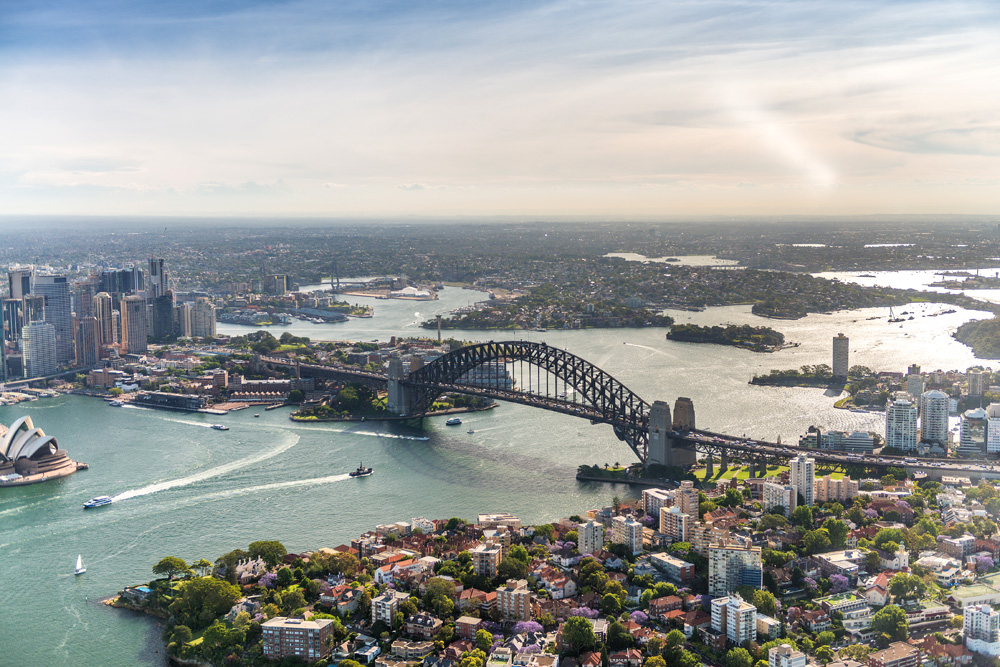
3. The Great Barrier Reef – Australia
The Great Barrier Reef is one of the Seven Natural Wonders of the World and is the largest coral reef system in the world, 2300 kilometres/1400 miles long off the coast of Queensland. To imagine its size, it is roughly as big in area as Italy, Japan, or Germany and half as big as Texas. It is also the only living thing on earth visible from outer space. The Reef is made of billions of tiny living organisms which make it the largest living organism in the world, with over 3000 coral reefs and 880 islands – of which 27 islands are inhabited. An interesting fact is that coral is actually a herbivore. At night, polyps open up and grab tiny shrimps and other living things floating in the current. They have jellyfish like tentacles and suck in their prey. There are huge tropical rain forests on some islands that get some of the most rainfall in the world. The forests are vital to the reef because they filter the sediments that come through the rivers which kill the marine life. The greatest threat to the Great Barrier Reef is actually climate change, which affects both the coral and marine life. Other dangers are pollution and over-fishing, both of which reduce the food chain.
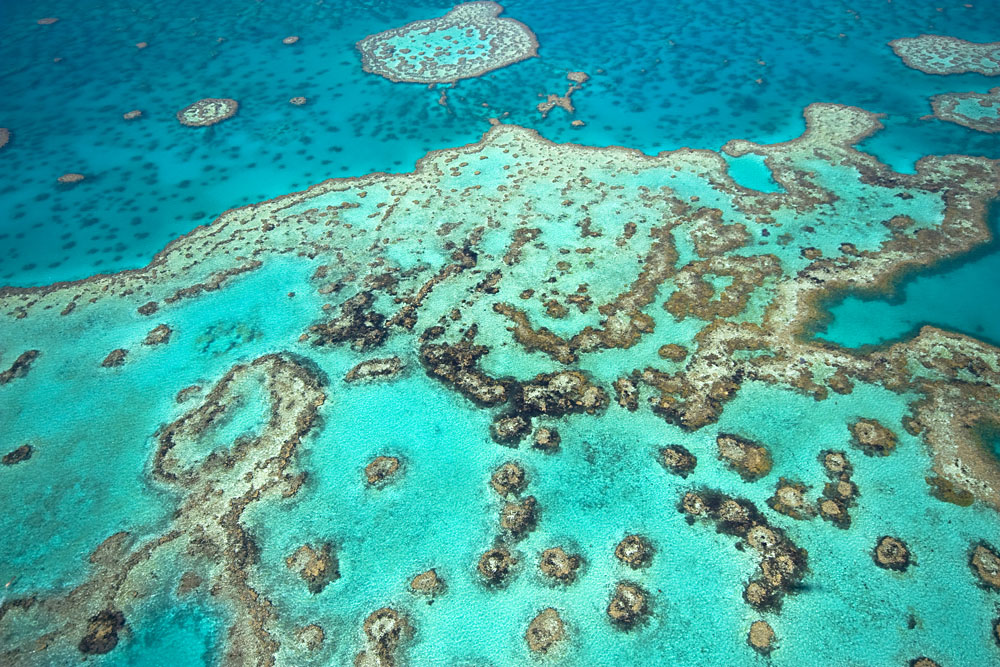
There are literally hundreds of picturesque tropical islands with some of the world’s most beautiful sun-soaked, golden beaches. You can enjoy a day trip from Cairns or Port Douglas on a catamaran cruise. You can indulge in any of the 2 to 7 day passenger cruises available. You can take a scenic flight from both Cairns and Port Douglas. Or you can stay at one of the resorts on a number of islands. Some of the better known are the Whitsundays group, Hamilton Island, Heron Island, Lizard Island, Green Island, and Hayman Island.

4. The Outback – Australia
The Outback of Australia is more of a colloquial term than a geographical area. It refers to the vast, remote, arid interior of Australia. It is also known as the “Never-Never,” the “Back of Beyond,” and the “Back o’Burke.” The open spaces in the Outback seem to stretch on forever and reflect Australia’s pioneering spirit and identity. You can find a little bit of the Outback in every state of Australia. Arid and semi-arid desert lands make up 70 per cent of mainland Australia. A large proportion of this land is held by Aboriginal people through various property acts. The Outback is the only place where Australian Aborigines still live in a completely traditional way. Due to the low humidity and the lack of light pollution, the Outback is one of the best places in the world for stargazing. It is home to a significant number of rare fauna and flora species and is the habitat for rare, threatened, and endangered species. This includes 1800 types of plants such as the ubiquitous spinifex, which dominates the desert areas. There are over 605 vertebrate animals including wild camels, red kangaroos, desert dingoes, the Thorny Devil lizard, monitor lizards, and the bearded dragon lizard.

The renowned Ayers Rock, also known by its Aboriginal name, Uluru, is basically a very large piece of rock situated in the desert, a monolith of red sandstone rising out of the flat landscape. To the indigenous Aboriginal people, it is a very sacred place. To walk around the circumference is approximately 10 kilometres/6 miles and takes around 3.5 hours. One special aspect is it changes colour depending on the time of year and the time of day. Sunrise and sunset are particularly magical times to view Ayers Rock on a Downunder vacation when its terracotta hue morphs into a violet/blue tinge. The Olgas are a group of large ancient rock formations and are located in the Uluru-Kata Tjuta National Park and are believed to be around 500 million years old. Kings Canyon is a formation of tall red rock faces that soar above dense palm forests and is a refuge for more than 600 species of native plants and animals, many unique to the area.
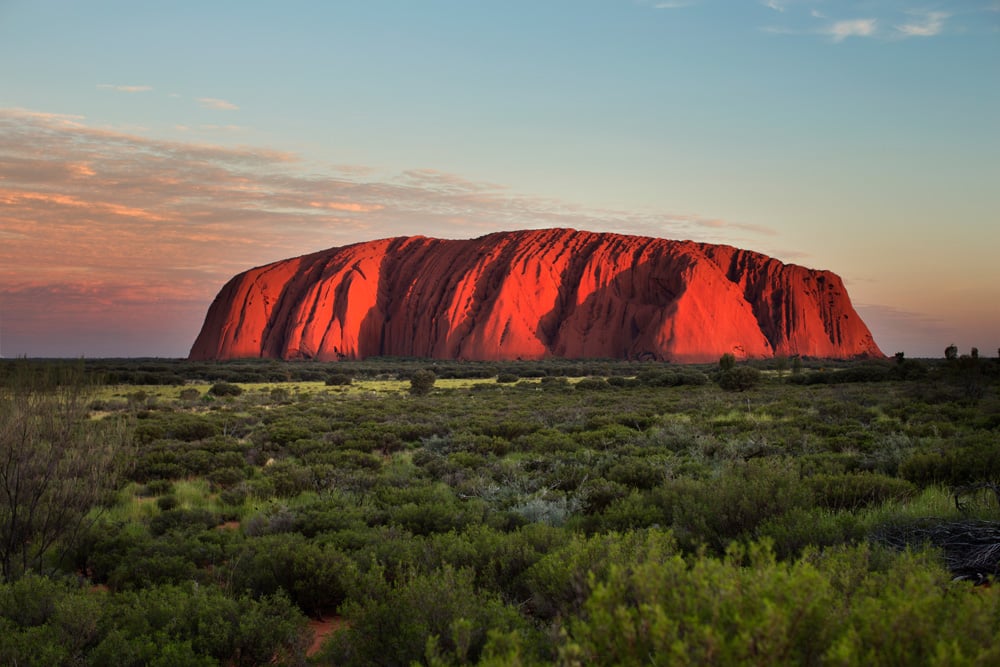
5. Blue Mountains – Australia
Not far from Sydney is exceptionally dramatic scenery, the colourful Blue Mountains. The name is derived from the blue haze you encounter when looking at them from a distance, and is believed to be caused by the vast forests of eucalyptus which, in the hot sun, discharge a fine mist of eucalyptus oil from their leaves. On Australian vacations, the Blue Mountains combine breathtaking views, rugged tablelands, sheer cliffs, deep, inaccessible valleys, and swamps teeming with wildlife. The area is extensively used for sightseeing and also for bushwalking, rock climbing, canyoning and other outdoor recreational pursuits. Probably the most impressive sight is the Three Sisters rock formation, close to the town of Katoomba. The Sisters were formed by land erosion, as the soft sandstone of the Blue Mountains was eroded over time by wind, rain and rivers causing the cliffs to be slowly broken up. The character of the Three Sisters changes throughout the day and the seasons as the sunlight brings out the magnificent colours. They are also floodlit at night, looking even more stunning set against the black background of the night sky.
Katoomba is the most visited town in the Blue Mountains. Katoomba Scenic World is a privately owned tourist attraction and home to four specific attractions, of which the most famous is the Katoomba Scenic Railway, the steepest cable-driven funicular railway in the world, originally constructed for a coal and oil shale mining operation. It has a glass bottom which provides breathtaking views. The Scenic Skyway is another cable-driven conveyance at Scenic World and travels across a gorge above the Katoomba Falls.
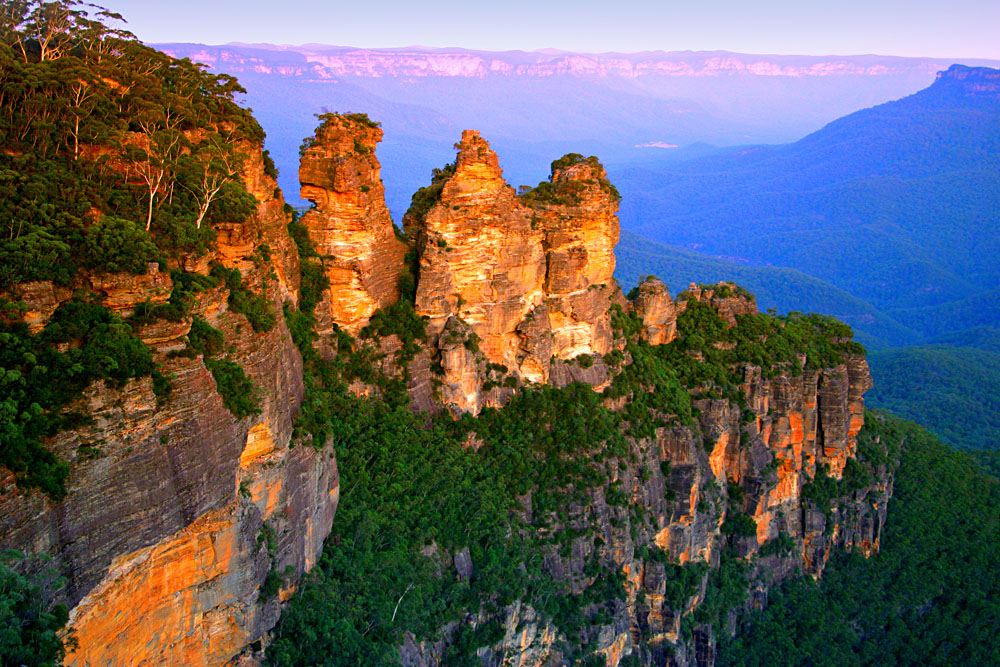
6. Fiordland National Park – New Zealand
Fiordland is the largest national park in New Zealand, located in the south west corner of the South Island, just 2 hours by road from Queenstown or Invercargill. The park has stunning fiords, spectacular waterfalls, snow-capped peaks, ancient rainforests clinging to the mountain sides, and shimmering lakes. The west coast is deeply indented by 14 fiords stretching over 215 kilometres/135 miles of coastline. The main towns are Te Anau and Manapouri. On all sides of these fiords, spectacular waterfalls tumble incessantly as the region’s plentiful rainfall finds its way to the sea.
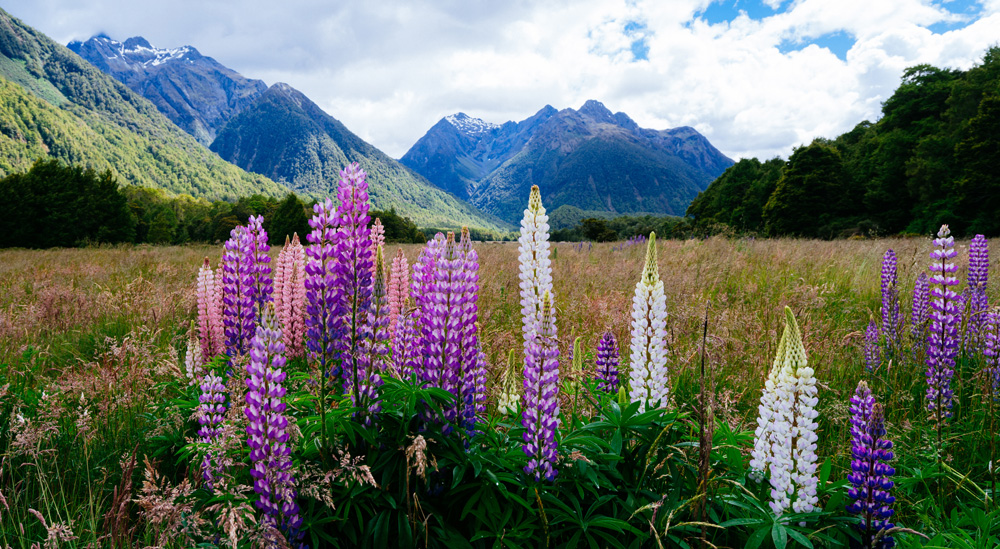
If you want a leisurely way to enjoy the spectacular scenery on a Downunder vacation, then a cruise is the way to go. Described by Rudyard Kipling as the “Eighth Wonder of the World,” cruising along the Milford Sound gives you the opportunity to take in the splendour of the region. You will see mammals and sea creatures including dolphins that love to put on a show, and penguins that waddle across rocks. You will see dramatic sheer cliffs, massive waterfalls, glaciers, and rainforest. Cruises usually last approximately 90 minutes. Another cruise is a 3 hour one on Lake Te Anau, the largest of the southern glacial lakes. The main body of the lake has three large fiords which reach out from its western side. These “arms” are called North Fiord, Middle Fiord, and South Fiord. Rolling hill country characterizes the eastern side of the lake while the western side is a magnificent wilderness of forest and mountains.

7. Bay of Islands – New Zealand
The Bay of Islands is for those who are looking for a subtropical New Zealand vacation, where beaches exist amid attractive small towns. Known for its stunning beauty and its historical significance, the Bay of Islands encompasses some 140 islands complete with sandy beaches, hidden coves, dramatic coastlines and sophisticated small urban areas. Activities in which you can participate include swimming, cruising, sailing, deep sea fishing, golf, diving, and walking. However, the real attraction here is the scenery which features a coastline backed by a green rolling landscape. This was the birthplace of European colonization of New Zealand and was also the site of the first British settlement. Maoris inhabited the area and is of great significance to them as it is to the early European settlers. It was here that the 1840 Treaty of Waitangi was signed between the Maori and the British. Waitangi’s importance to New Zealand cannot be overstated as it was here that a nation was born.
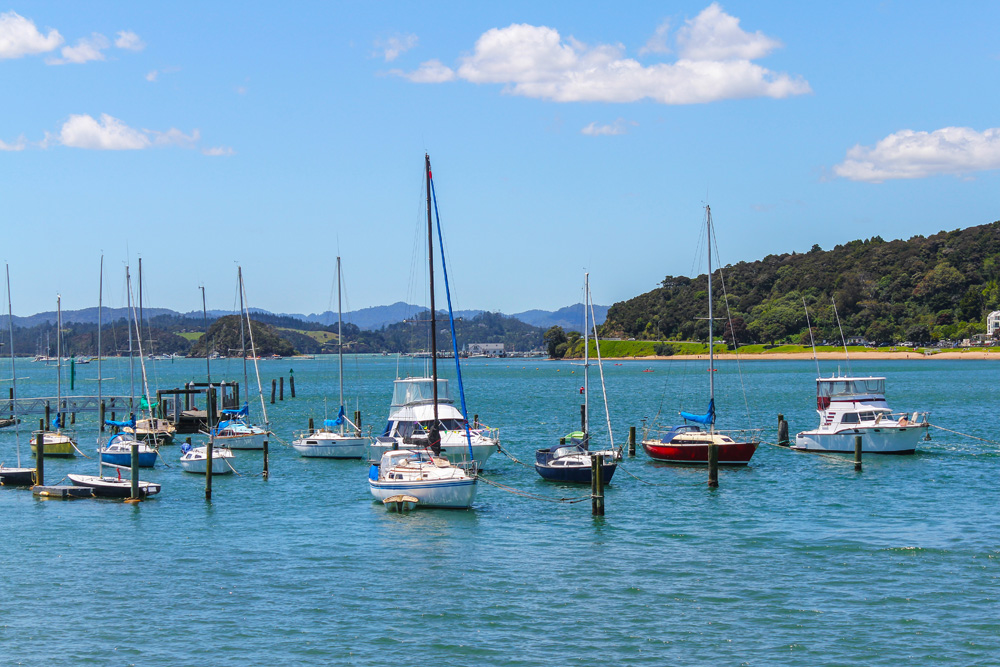
The resort town of Paihia is known as the “Jewel of the Bay of Islands” and is the hub of activity with ferry boats leaving from here to most other major islands. There is abundant shopping, a lively nightlife, and excellent restaurants offering exquisite food and fine wine. Paihia is a base from which game fishing, swimming with dolphins, and lazy days on the beach are all available. Close by is the site of the Treaty of Waitangi, known as the “Birthplace of the Nation,” New Zealand’s most important cultural site. Across the bay from Paihia is the historic town of Russell, reached by ferry. Russell was New Zealand’s first capital. The town has an unforgettable charm with its timeless appeal and where history comes alive. It is ideally located for taking advantage of some wonderful walks and cycling routes along the coastline, passing through ancient forests and giving you unforgettable and spectacular viewpoints across the sea.
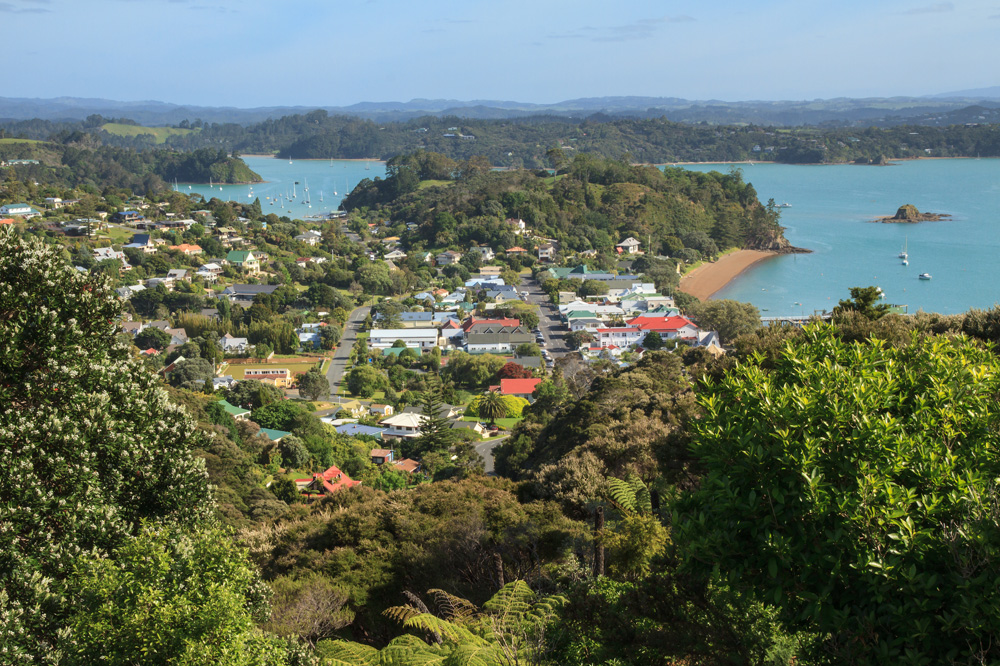
8. Rotorua – New Zealand
Rotorua is a city on the southern shores of the lake of the same name in New Zealand’s North Island. The region offers some of the world’s most active geothermal activity. Along with the incredible geothermal attraction, it is a volcanic wonderland with extraordinary landscapes to be enjoyed on a Downunder vacation. It is also a region rich in Maori history and folklore. Thermal activity is definitely at the heart of much of Rotorua’s appeal. Whakarewarewa is one of Rotorua’s most popular geothermal sites offering some excellent geothermal activity and a traditional Maori village. With approximately 500 hot springs in the area, the terraces and pools are known as a Living Thermal Village. The Pohutu Geyser erupts to a height of 30 metres/100 feet up to 20 times a day. Another exceptional thermal wonderland here is Wai-O-Tapu, with its large number of mud pools, geysers, and sulphur pools. It also includes the Lady Knox Geyser which erupts daily at 10:15am. Amazingly, it is artificially induced but it produces a jet of water reaching up to 20 metres/65 feet. The ominous sounding Hell’s Gate is actually Rotorua’s most famous thermal attraction. It is also a sacred Maori site with a wide area containing mud pools, geysers, hot springs, and the Southern Hemisphere’s largest hot-water waterfall. One more to add to the list is the wonderful sounding Craters of the Moon. This is actually a geothermal walk which features mud craters simply steaming with geothermal activity.
At the New Zealand Maori Arts and Crafts Institute, known as Te Puia, you can view and learn about traditional Maori arts and speak with expert carvers and weavers and learn the history and processes involved with these arts. Rainbow Springs is the place for a look at New Zealand‘s iconic Kiwi and to learn more about nature on the water ride, The Big Splash. There is also a farm show which features trained rams, sheepdogs, sheep shearing, singing, dancing, and the Haka war dance, together with delicious Maori food.
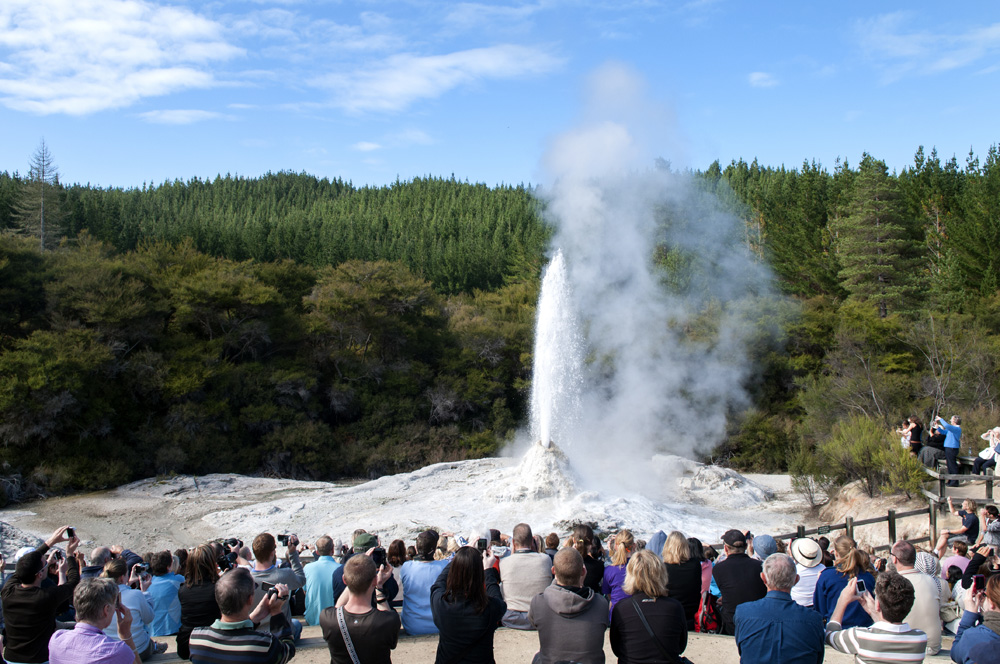
Get more travel inspiration by email.
Subscribe
0 Comments

Get the latest travel trends & hear about the best deals on vacations around the world.
If you’re a Globetrotter, these are the newsletters for you!

